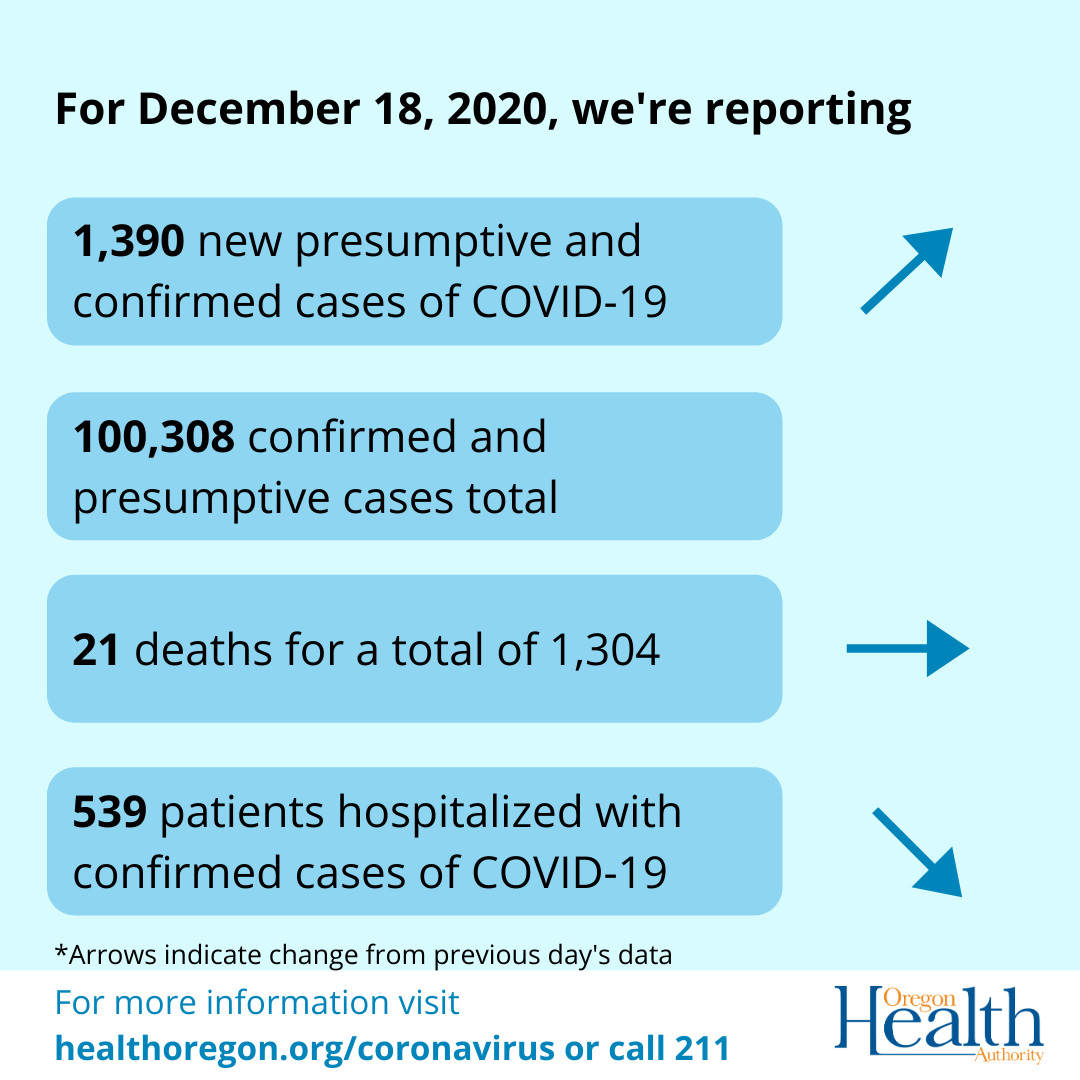PORTLAND, Ore. — Today, Oregon has crossed another threshold since COVID-19 was first detected in our state in February, with more than 100,000 cases reported. The virus has claimed 21 more lives in Oregon, raising the state’s death toll to 1,304 the Oregon Health Authority reported at today December 18th.
OHA reported 1,390 new confirmed and presumptive cases of COVID-19 bringing the state total to 100,308.
The new confirmed and presumptive COVID-19 cases reported today are in the following counties: Baker (7), Benton (34), Clackamas (117), Clatsop 6), Columbia (6), Coos (18), Crook (10), Curry (10), Deschutes (59), Douglas (14), Grant (3), Harney (2), Hood River (29), Jackson (76), Jefferson (27), Josephine (30), Klamath (62), Lake (1), Lane (93), Lincoln (7), Linn (43), Malheur (17), Marion (153), Morrow (4), Multnomah (200), Polk (18), Tillamook (15), Umatilla (59), Union (1), Wasco (30), Washington (221), Yamhill (18).
OHA Public Health Director Rachael Banks noted the milestone: “While this significant number reflects how widely the novel coronavirus has spread within our communities, I want to acknowledge every Oregonian who has been affected by this pandemic and thank the vast majority of Oregonians who’ve taken steps to protect their families, their neighbors, and the most vulnerable members of our communities.”
“COVID-19 hasn’t spread as fast as it has in most other states. But every infection, every hospitalization and every death are one too many. The safe and effective vaccines we’re distributing across the state offer real hope we can end this pandemic. But it’s too soon to drop our guard.”
Both Idaho and Nevada, two of our neighboring states with fewer residents, have reported more total cases — more than 125,000 for Idaho and 194,000 for Nevada. Oregon also has the 44th lowest level of average daily cases among all states, according the Centers for Disease Control and Prevention.
As we now head into upcoming winter holidays, today’s milestone also serves as a reminder of ways each of us can stay healthy and safe and prevent more infections:
- Maintain six feet of physical distance;
- Wear a face covering when outside the house;
- Practice good hand hygiene;
- Avoid any gatherings with non-household members;
- If you start to have symptoms — even mild ones — consult with a medical provider quickly to get instructions on how to care for yourself and your household members and whether to get tested;
- And lastly, if you get a call from public health, answer it, and take their advice on how to protect yourself and those around you.
Modeling projections show cases increasing
Today the OHA released its latest modeling which shows a projected increase in COVID-19 cases and that more Oregonians are staying home and physically distant.
According to the model, the effective reproduction rate — the expected number of secondary cases that a single case generates — was estimated to be 1.22 as of Nov. 28.
The current level of transmission could result in in approximately 2,200 new daily cases and 110 additional daily hospitalizations by Jan 1.
If people are not diligent about mask wearing and physical distancing, resulting in a rise in transmission like what Oregon experienced in early November, new daily cases could rise to 2,550. COVID-19 patients needing hospital care in the next two weeks would similarly rise, to 125 per day.
Conversely, if people remain diligent against the virus, transmission could mirror the levels from mid-October, with daily cases at about 1,200. Under that scenario hospitalizations would drop substantially to about 55 per day.
The model shows that Oregonians are travelling less frequently and that three out of four are regularly wearing masks or face coverings.
COVID-19 hospitalizations
The number of hospitalized patients with COVID-19 across Oregon is 539, which is 12 fewer than yesterday. There are 111 COVID-19 patients in intensive care unit (ICU) beds, which is two fewer than yesterday.
The total number of patients in hospital beds may fluctuate between report times. The numbers do not reflect admissions per day, nor the length of hospital stay. Staffing limitations are not captured in this data and may further limit bed capacity.
More information about hospital capacity can be found here.
Cases and deaths
Mental and emotional resources for difficult times:
- Mental and emotional health resources are available on OHA’s Safe + Strong website.
- Or call the Safe + Strong Helpline at 800-923-4357 (800-923-HELP). The line offers free, 24-7 emotional support and resource referral to anyone who needs it — not only those experiencing a mental health crisis.


